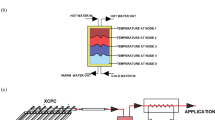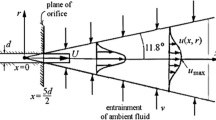Abstract
Solar energy is one of the major sources of renewable energy and is being extensively harnessed. However, the intermittent nature limits solar energy to act as a stand-alone energy source. Therefore, it becomes imperative that effective and economical methods of storing solar energy on a large scale are developed. Both sensible and latent heat storage methods are available. The use of a thermal energy storage (TES) system is an attractive choice for high-temperature applications such as power generation plants. The present study investigates the development of a small-scale TES system using a concentrated solar collector. For this purpose, a small cylindrical thermocline tank with suspended copper pipes in the storage medium was developed, with vegetable oil working as the heat transfer fluid (HTF) and being circulated through the pipes to transfer heat to used engine oil as the storage medium. A pump continuously circulates the HTF through the charging loop. TES was designed and developed based on the results of numerical simulations before the physical development of the experimental setup. Numerical calculations were performed for determining heat transfer and charging characteristics using different heat storage materials. The numerical results showed that a maximum temperature of 67 °C was achieved in the 100-min simulation while in the experimental results, a maximum temperature of 64 °C was achieved. The experimental results were found in close conformance with the simulation results. The experiments showed that the flow rate of 0.088 L s−1 was optimal and provided the highest temperature in the thermocline tank. The discharging experiment showed that the apparatus is viable to be used for 5.5 h for heating purposes. The salient feature of the study is an inexpensive TES system development and can act as a benchmark for the future development of renewable technology.









Similar content being viewed by others
Abbreviations
- \(\dot{m}\) :
-
Mass flow rate (kg s−1)
- \({C}_{\text{p(water)}}\) :
-
Specific heat capacity of water (J kg−1K−1)
- \({C}_{\text{p(HTF)}}\) :
-
Specific heat capacity of heat transfer fluid (J kg−1 K−1)
- \(\Delta T\) :
-
Temperature difference (K)
- \({E}_{\text{req(steam)}}\) :
-
Energy required for steam generation during discharging (MJ)
- \({E}_{\text{req(HTF)}}\) :
-
Energy required to be provided by HTF for charging (MJ)
- \({E}_{\text{req(storage)}}\) :
-
Energy required to be stored in storage medium (MJ)
- \({\text{Density}}_{\text{(storage)}}\) :
-
Density of the storage medium (sand) (kg m−3)
- \({\text{Volume}}_{\text{(storage)}}\) :
-
Volume of the storage medium (m3)
- V r :
-
Radial velocity (m s−1)
- V θ :
-
Tangential velocities (m s−1)
- V z :
-
Axial velocities (m s−1)
- g :
-
Acceleration due to gravity (m s−2)
- V :
-
Kinematic viscosity of the fluid (m2 s−1)
- ρ :
-
Fluid’s density (kg m−3)
- \({C}_{\text{pf}}\) :
-
Specific heat of the working fluid (J kg−1 K−1)
- \({T}_{\text{f}}\) :
-
Fluid temperature (K)
- \({k}_{\text{f}}\) :
-
Thermal conductivity of fluid (W m−1 K−1)
- \({k}_{\text{s}}\) :
-
Thermal conductivity of solid (W m−1 K−1)
- \({T}_{\text{s}}\) :
-
Temperature of the solid domain (K)
- TES:
-
Thermal energy storage
- CSP:
-
Concentrated solar power
- PCM:
-
Phase change material
- CPC:
-
Compound parabolic collector
- HTF:
-
Heat transfer fluid
References
Afshari F, Muratçobanoğlu B, Mandev E, Ceviz MA, Mirzaee Z. Effects of double glazing, black wall, black carpeted floor and insulation on thermal performance of solar-glazedbalconies. Energy Build. 2023;285:112919. https://doi.org/10.1016/j.enbuild.2023.112919.
Afshari F, Mandev E, Muratçobanoğlu B, Yetim AF, Ceviz MA. Experimental and numerical study on a novel fanless air-to-air solar thermoelectric refrigerator equipped with boosted heat exchanger. Renew Energy. 2023;207:253–65. https://doi.org/10.1016/j.renene.2023.02.092.
Gautam A, Chamoli S, Kumar A, Singh S. A review on technical improvements, economic feasibility and world scenario of solar water heating system. Renew Sustain Energy Rev. 2017;68:541–62. https://doi.org/10.1016/j.rser.2016.09.104.
Jamar A, Majid ZAA, Azmi WH, Norhafana M, Razak AA. A review of water heating system for solar energy applications. Int Commun Heat Mass Transf. 2016;76:178–87. https://doi.org/10.1016/j.icheatmasstransfer.2016.05.028.
Afshari F. Experimental comparative analysis of solar system productivity and performance in water distillation: solar stills vs. parabolic dish systems. Desalination. 2024;577:117402. https://doi.org/10.1016/j.desal.2024.117402.
Gilani HA, Hoseinzadeh S. Techno-economic study of compound parabolic collector in solar water heating system in the northern hemisphere. Appl Therm Eng. 2021;190:116756. https://doi.org/10.1016/j.applthermaleng.2021.116756.
Ahmadi MH, Ghazvini M, Maddah H, Kahani M, Pourfarhang S, Pourfarhang A, Heris SZ. Prediction of the pressure drop for CuO/(ethylene glycol-water) nanofluid flows in the car radiator by means of artificial neural networks analysis integrated with genetic algorithm. Phys A Stat Mech Appl. 2020;546:124008. https://doi.org/10.1016/j.physa.2019.124008.
Panagiotidou M, Aye L, Rismanchi B. Solar driven water heating systems for medium-rise residential buildings in urban mediterranean areas. Renew Energy. 2020;147:556–69. https://doi.org/10.1016/j.renene.2019.09.020.
Wang Z, Qiu F, Yang W, Zhao X. Applications of solar water heating system with phase change material. Renew Sustain Energy Rev. 2015;52:645–52. https://doi.org/10.1016/j.rser.2015.07.184.
Ahmadi MH, Baghban A, Sadeghzadeh M, Hadipoor M, Ghazvini M. Evolving connectionist approaches to compute thermal conductivity of TiO2/water nanofluid. Phys A Stat Mech Appl. 2020;540:122489. https://doi.org/10.1016/j.physa.2019.122489.
Zou B, Dong J, Yao Y, Jiang Y. An experimental investigation on a small-sized parabolic trough solar collector for water heating in cold areas. Appl Energy. 2016;163:396–407. https://doi.org/10.1016/j.apenergy.2015.10.186.
Bhujangrao KH. Design and development of prototype cylindrical parabolic solar collector for water heating application. Int J Renew Energy Dev. 2016;5:49–55. https://doi.org/10.14710/ijred.5.1.49-55.
Ma Z, Glatzmaier GC, Kutscher CF. Thermal energy storage and its potential applications in solar thermal power plants and electricity storage. Energy Sustain. 2011. https://doi.org/10.1115/ES2011-54077.
Ahmadi MH, Dehshiri SSH, Dehshiri SJH, Mostafaeipour A, Almutairi K, Ao HX, Rezaei M, Techato K. A thorough economic evaluation by implementing solar/wind energies for hydrogen production: a case study. Sustainability. 2022. https://doi.org/10.3390/su14031177.
Hasnain SM. Review on sustainable thermal energy storage technologies, part I: Heat storage materials and techniques. Energy Convers Manag. 1998;39:1127–38. https://doi.org/10.1016/S0196-8904(98)00025-9.
Flueckiger SM, Garimella SV. Latent heat augmentation of thermocline energy storage for concentrating solar power—a system-level assessment. Appl Energy. 2014;116:278–87. https://doi.org/10.1016/j.apenergy.2013.11.059.
Wu W, Dai S, Liu Z, Dou Y, Hua J, Li M, Xinyu W, Xiaoyu W. Experimental study on the performance of a novel solar water heating system with and without PCM. Sol Energy. 2018;171:604–12. https://doi.org/10.1016/j.solener.2018.07.005.
Mousavi SA, Hafezalkotob A, Ghezavati V, Abdi F, Mobarra R. Sustainable construction project of electric vehicle charging stations: a risk-based hybrid decision-making approach. J Clean Prod. 2023;402:136565. https://doi.org/10.1016/j.jclepro.2023.136565.
Tesfay M, Venkatesan M. Simulation of thermocline thermal energy storage system using C. Int J Innov Appl Stud. 2013;3:354–64.
Ahmadi MH, Kumar R, Assad MEH, Ngo PTT. Applications of machine learning methods in modeling various types of heat pipes: a review. J Therm Anal Calorim. 2021;146:2333–41. https://doi.org/10.1007/s10973-021-10603-x.
Wang Z, Gu Y, Lu S, Zhao Z. Optimization of thermocline heat storage tank capacity for combined heat and power plant based on environmental benefits: scenarios for China. J Energy Storage. 2023;57:106303. https://doi.org/10.1016/j.est.2022.106303.
Ghebrezgabher MG, Weldegabir AK. Estimating solar energy potential in Eritrea: a GIS-based approach. Renew Energy Res Appl. 2022;3:155–64. https://doi.org/10.22044/rera.2022.11737.1106.
Biencinto M, Bayón R, Rojas E, González L. Simulation and assessment of operation strategies for solar thermal power plants with a thermocline storage tank. Sol Energy. 2014;103:456–72. https://doi.org/10.1016/j.solener.2014.02.037.
Cocco D, Serra F. Performance comparison of two-tank direct and thermocline thermal energy storage systems for 1MWe class concentrating solar power plants. Energy. 2015;81:526–36. https://doi.org/10.1016/j.energy.2014.12.067.
Gielen D. Renewable energy technologies: cost analysis series. Sol Photovolt. 2012;1, Power Sector, Issue 4, Working Paper: International Renewable Energy Agency (IRENA)
Valmiki MM, Karaki W, Li P, Van LJ, Chan C, Stephens J. Experimental investigation of thermal storage processes in a thermocline tank. J Sol Energy Eng Trans ASME. 2012;134:1–9. https://doi.org/10.1115/1.4006962.
Zhang M, Xu C, Du X, Amjad M, Wen D. Off-design performance of concentrated solar heat and coal double-source boiler power generation with thermocline energy storage. Appl Energy. 2017;189:697–710. https://doi.org/10.1016/j.apenergy.2016.12.095.
Dai Y, Chen L, Min Y, Chen Q, Zhang Y, Xu F, Hu K, Hao J. Active and passive thermal energy storage in combined heat and power plants to promote wind power accommodation. J Energy Eng. 2017;143:04017037. https://doi.org/10.1061/(ASCE)EY.1943-7897.0000466.
Rehman H, Hirvonen J, Sirén K. Influence of technical failures on the performance of an optimized community-size solar heating system in Nordic conditions. J Clean Prod. 2018;175:624–40. https://doi.org/10.1016/j.jclepro.2017.12.088.
Bauer T, Steinmann WD, Laing D, Tamme R. Next-generation energy storage materials and systems. Mater. Res. Soc. Symp. Proc. 2012;1440
Yi Y, Nakayama A. An analytical study on transient thermal behavior of a packed-bed molten salt thermocline thermal storage. Int J Heat Mass Transf. 2023;209:124095. https://doi.org/10.1016/j.ijheatmasstransfer.2023.124095.
Wen P, Van J, Karaki W, Lik C, Stephens J, O’Brien EJ. Transient heat transfer and energy transport in packed bed thermal storage systems. In: de Bernardes MAS, editor. Developments in heat transfer. London: InTech; 2011. p. 373–416. https://doi.org/10.5772/20979.
Bayón R, Rojas E. Simulation of thermocline storage for solar thermal power plants: from dimensionless results to prototypes and real-size tanks. Int J Heat Mass Transf. 2013;60:713–21. https://doi.org/10.1016/j.ijheatmasstransfer.2013.01.047.
Cagnoli M, Gaggioli W, Liberatore R, Russo V, Zanino R. CFD modelling of an indirect thermocline energy storage prototype for CSP applications. Sol Energy. 2023;259:86–98. https://doi.org/10.1016/j.solener.2023.05.019.
Shaikh W, Wadegaonkar A, Kedare SB, Bose M. Numerical simulation of single media thermocline-based storage system. Sol Energy. 2018;174:207–17. https://doi.org/10.1016/j.solener.2018.08.084.
Fandi OM, Dol SS, Alavi M. Review of renewable energy applications and feasibility of tidal energy in the United Arab Emirates. Renew Energy Res Appl. 2022;3:165–74. https://doi.org/10.22044/rera.2022.11747.1107.
Marefati M, Mehrpooya M, Shafii MB. Optical and thermal analysis of a parabolic trough solar collector for production of thermal energy in different climates in Iran with comparison between the conventional nanofluids. J Clean Prod. 2018;175:294–313. https://doi.org/10.1016/j.jclepro.2017.12.080.
Adnan S, Khan AH, Haider S, Mahmood R. Solar energy potential in Pakistan. J Renew Sustain Energy. 2012. https://doi.org/10.1063/1.4712051.
Incropera FP, DeWitt DP. Fundamentals of heat and mass transfer. New York: Wiley; 2002.
Goswami DY, Kreith F, Kreider JF. Principles of solar engineering. Boca Raton: CRC Press; 2000.
Xie B, Baudin N, Soto J, Fan Y, Luo L. Experimental and numerical study on the thermocline behavior of packed-bed storage tank with sensible fillers. Renew Energy. 2023;209:106–21. https://doi.org/10.1016/j.renene.2023.03.107.
Acknowledgements
The authors acknowledge the support of the Ghulam Ishaq Khan Institute of Engineering Sciences and Technology, Topi, 23460, KPK, Pakistan, and its Interdisciplinary Engineering, Modelling and Simulation Research Group (IEMSRG) in carrying out the present research work.
Author information
Authors and Affiliations
Contributions
T A Cheema was contributed conceptualization and methodology. H Javaid was involved in numerical simulation and write up. H Yildizhan was performed data curation and analysis. M H Tariq did design of experiments. M T Basharat and Z M Subhani were done test setup development and experimentation. O Fakhraei was responsible for writing—original draft preparation and literature review. S Gorjian was attributed reviewing and editing. M H Ahmadi did investigation. C Pandey was done supervision.
Corresponding author
Additional information
Publisher's Note
Springer Nature remains neutral with regard to jurisdictional claims in published maps and institutional affiliations.
Rights and permissions
Springer Nature or its licensor (e.g. a society or other partner) holds exclusive rights to this article under a publishing agreement with the author(s) or other rightsholder(s); author self-archiving of the accepted manuscript version of this article is solely governed by the terms of such publishing agreement and applicable law.
About this article
Cite this article
Cheema, T.A., Javaid, H., Yildizhan, H. et al. Experimental and numerical investigation of a solar thermocline system for domestic water heating applications. J Therm Anal Calorim (2024). https://doi.org/10.1007/s10973-024-13148-x
Received:
Accepted:
Published:
DOI: https://doi.org/10.1007/s10973-024-13148-x




